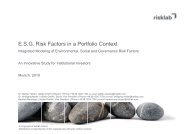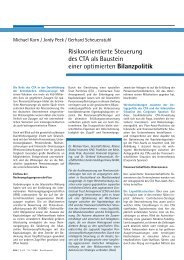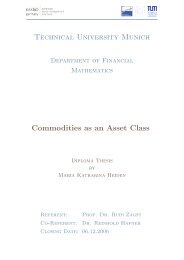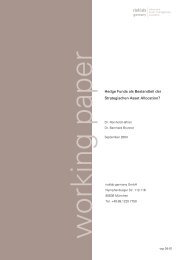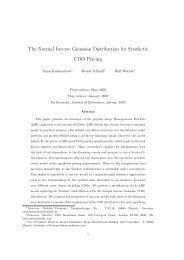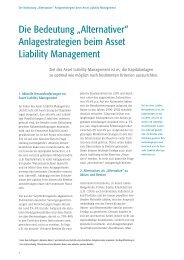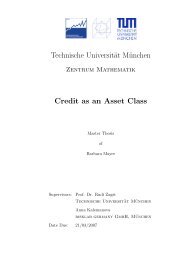Empirical Evaluation of Hybrid Defaultable Bond Pricing ... - risklab
Empirical Evaluation of Hybrid Defaultable Bond Pricing ... - risklab
Empirical Evaluation of Hybrid Defaultable Bond Pricing ... - risklab
You also want an ePaper? Increase the reach of your titles
YUMPU automatically turns print PDFs into web optimized ePapers that Google loves.
models originated with Jarrow & Turnbull (1992). Since that time a long list <strong>of</strong><br />
papers has appeared which follow this approach. Some <strong>of</strong> the most important<br />
ones are the following. Jarrow & Turnbull (1995) present a model where default<br />
is driven by a Poisson process with a constant intensity parameter and a given<br />
pay<strong>of</strong>f at default. In Lando (1994), Lando (1996), and Lando (1998) default<br />
is driven by Cox processes, which can be thought <strong>of</strong> as Poisson processes with<br />
random intensity parameters. Duffie & Singleton (1997) and Duffie & Singleton<br />
(1998) show that valuation under the risk-adjusted probability measure can be<br />
executed by discounting the non-defaultable pay<strong>of</strong>f on the debt by a discount<br />
rate that is adjusted for the parameters <strong>of</strong> the default process. Schönbucher<br />
(1996) presents a generalization in a Heath-Jarrow-Morton framework 1 that<br />
allows for restructuring <strong>of</strong> defaulted debt and multiple defaults.<br />
<strong>Empirical</strong> evidence concerning reduced-form models is rather limited. Duffee<br />
(1999) Þnds that these models have difficulty in explaining the observed term<br />
structure <strong>of</strong> credit spreads across Þrms <strong>of</strong> different credit risk qualities. Düllmann<br />
& Windfuhr (2000) consider speciÞc Vasicek and CIR type reduced form<br />
models and show that both models fail to account for all observed shapes <strong>of</strong> the<br />
credit spread structure.<br />
There is a heated debate which class <strong>of</strong> models - structural or reduced-form<br />
- is best (see, e.g., Jarrow, Deventer & Wang (2003)). Jarrow & Protter (2004)<br />
compare structural and reduced-form models from an information based perspective.<br />
They claim that the models are basically the same - the only distinction<br />
between the two model types is not whether the default time is predictable<br />
or inaccessible, but whether the information is observed by the market or not.<br />
Structural models assume that the modeler has the same complete information<br />
as the Þrm’s manager, whereas reduced-form models assume that the modeler<br />
has the same incomplete information as the market. They conclude that for<br />
pricing and hedging, reduced form models are the preferred methodology.<br />
<strong>Hybrid</strong> models try to combine ideas <strong>of</strong> structural and reduced-form models<br />
and to get rid <strong>of</strong> their drawbacks. Basically these models can be seen as a variant<br />
<strong>of</strong> reduced-form modeling with state variables. The conditional probability<br />
<strong>of</strong> default is directly related to speciÞc macro- and/or microeconomic factors.<br />
Microeconomic factors can contain Þrm speciÞc structural information. Important<br />
examples are Madan & Unal (1998), Cathcart & El-Jahel (1998), Davydov,<br />
Linetsky & Lotz (1999), Madan & Unal (2000), Schmid & Zagst (2000), and<br />
Bakshi, Madan & Zhang (2001a). One <strong>of</strong> the factors that determine the credit<br />
spread in the model <strong>of</strong> Schmid & Zagst (2000) is the so called uncertainty index<br />
which can be understood as an aggregation <strong>of</strong> all information on the quality <strong>of</strong><br />
the Þrm currently available: The greater the value <strong>of</strong> the uncertainty process<br />
the lower the quality <strong>of</strong> the Þrm. A similar idea to this uncertainty process was<br />
1 For an introduction to the Heath-Jarrow-Morton framework see, e.g., Heath, Jarrow &<br />
Morton (1992).<br />
3



